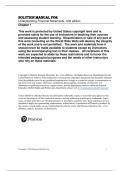Exam (elaborations)
Solution Manual for Understanding Financial Statements, 12th Edition by Lyn M. Fraser, Aileen Ormiston
- Course
- Institution
Solution Manual for Understanding Financial Statements, 12th Edition by Lyn M. Fraser, Aileen Ormiston
[Show more]



